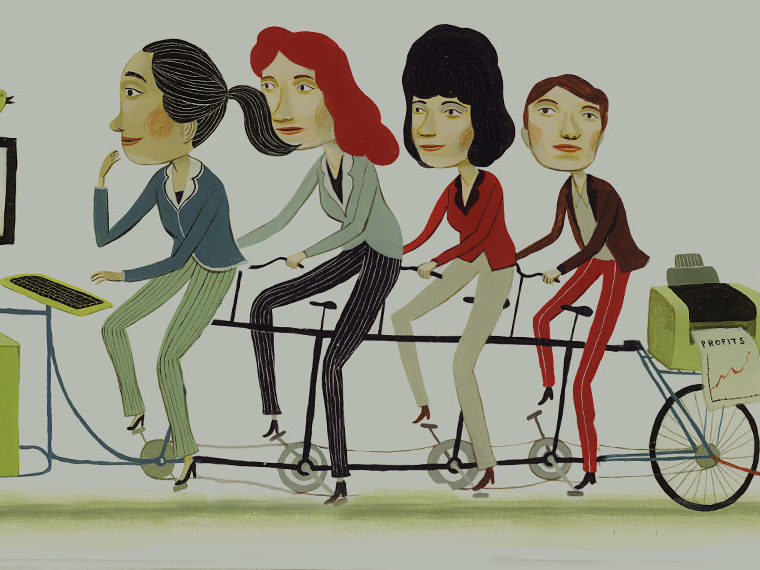It’s generally a positive in both cultures, but buy-in is more tentative in China
The potential business value of creating a workplace that solicits the input of employees in building and evolving best practices has long captured the attention of controlling stakeholders.
Academics are all over it as a central piece of organizational management theory and social psychology. In turn, C-suites — and the consultants who feed off of them — are motivated to follow “worker participation” insights that might help move a business forward.
Opt In to the Review Monthly Email Update.
What’s less likely to be studied is whether the actual target of workplace participation — employees — consider it a force for good or a tool solely to advance management’s agenda.
Research published in Frontiers in Psychology tackles that question with an interesting cultural twist. Across three experiments, UCLA Anderson’s Sherry Jueyu Wu and pre-doctoral research fellows at UCLA Bruce Yuhan Mei and Jose Cervantez studied how full-time workers in the United States and China perceive the concept of worker participation and how they rate its utility.
While the U.S. and China lead the global economy, the social, political and cultural underpinnings of the countries are vastly different. The researchers found a common belief that worker participation was a net positive. But underneath that, Chinese workers are less sure of the personal and business payoff of working in a business that seeks out a high level of employee participation.
The View from the Lower Rungs
The researchers started by asking full-time workers (149 American, 211 Chinese) to free-associate any words that came to mind when presented with the prompt of “worker participation.” Those responses were then sorted into a handful of overarching mega-categories, such as positivity (words such as responsible, friendly, integrity), teamwork (words such as cooperate, working together), and extrinsic, a catchall for words related to the potential reward or cost (words such as money, time).
Among both Americans and Chinese, words that sorted into the positivity or teamwork bins were ranked highest. But with different emphasis. Among American participants, nearly two-thirds mentioned words that relate to positivity and 59% mentioned words that relate to teamwork. For the Chinese, teamwork was the most oft-cited category, but at a much lower 36%, and positivity was in second place, with a 33% mention rate.
From there, the researchers explored the extent to which workers perceive a participatory framework drives productivity, worker satisfaction and conflict.
A fresh batch of full-time workers (145 American, 205 Chinese) were asked to rate on a scale of 1 (strongly disagree) to 7 (strongly agree) their opinion of statements designed to measure their buy-in to different aspects of workplace participation. A score of 4.0 is neutral.
- “I wish to carry out my work in the way I think is the best” and “I’d prefer to work as a partner of my manager as opposed to as a subordinate” served as a general gauge for a participant’s opinion of workforce participation. Both Americans (4.69 average score) and Chinese workers (4.59) were net positive on workforce participation.
- “Companies that let their employees talk more generally have higher productivity” was a window into understanding how workers perceive the business value of worker participation. While both camps viewed this positively, Chinese workers leaned harder into the idea, with an average score of 5.25 compared with 4.98 for Americans.
- “I feel happier at work when I can express my thoughts on work related issues” gauged perceptions of how worker participation related to worker satisfaction. Here too, Chinese workers (5.4) were more on board than American workers (4.8) that participation can drive job satisfaction.
- “Companies that let employees talk more would experience more chaos” aimed to get a sense of worker perception of the conflict factor. Americans were marginally negative on the notion, giving it an average score of 3.94, compared with a 4.39 score from the Chinese participants.
What Workers Want: a Cultural Divide
While those studies suggest a generally positive conception of worker participation by both American and Chinese workers, that did not translate into a unified preference for wanting to be part of a workplace that embraced the participation model.
In another experiment, more than 200 American workers and another 200-plus Chinese workers were presented with two scenarios that asked them to envision they were a mid-level employee in a large company that specialized in manufacturing household goods and services.
In one scenario, the workplace was “low participation” where workers had little say in a hierarchical structure. In the “high participation” scenario, participants were asked to imagine starting the workday with an all-team group meeting, where decision making was more inclusive.
Across a series of questions, participants were asked to weigh in on what they thought of both scenarios, using the same 1 to 7 rating scale (7 being most positive).
Americans were clearly in favor of being part of a high participation environment (4.69 average score) compared with a low participation setting (3.17). And they believed a high participation environment would foster better productivity (5.7 versus 4.65) and job satisfaction (4.75 versus 3.36)
Things were murkier for the Chinese. While the high participation scenario received a net positive average score of 4.54, the low participation environment received an even higher score of 4.71.
That same dynamic played out in terms of productivity perceptions. The Chinese were positive on the notion that a high participation workplace would drive more productivity (average score of 4.89). But they effectively said they would be even more productive in a less inclusive top-down environment, as the average score for the low participation scenario was 5.11.
The researchers point out that while the high participation scenario was not viewed as positively as the low participation scenario, the 4.89 for the high-participation scenario was clearly positive.
“Culture was clearly a moderator in employees’ preference and perceived impact of workplace participation,” they conclude. “It is possible that the slight preference (among Chinese) to a low participation work environment reflects the familiarity to the default work environment that they encounter.”
Featured Faculty
-
Sherry Jueyu Wu
Assistant Professor of Management and Organizations and Behavioral Decision Making
About the Research
Wu, S.J., Mei, B.Y., Cervantez, J. (2022). Preferences and Perceptions of Workplace Participation: A Cross-Cultural Study. Frontiers in Psychology. https://doi.org/10.3389/fpsyg.2022.806481





